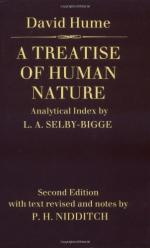It is therefore by experience only, that we can infer the existence of one object from that of another. The nature of experience is this. We remember to have had frequent instances of the existence of one species of objects; and also remember, that the individuals of another species of objects have always attended them, and have existed in a regular order of contiguity and succession with regard to them. Thus we remember, to have seen that species of object we call flame, and to have felt that species of sensation we call heat. We likewise call to mind their constant conjunction in all past instances. Without any farther ceremony, we call the one cause and the other effect, and infer the existence of the one from that of the other. In all those instances, from which we learn the conjunction of particular causes and effects, both the causes and effects have been perceived by the senses, and are remembered But in all cases, wherein we reason concerning them, there is only one perceived or remembered, and the other is supplyed in conformity to our past experience.
Thus in advancing we have insensibly discovered a new relation betwixt cause and effect, when we least expected it, and were entirely employed upon another subject. This relation is their constant conjunction. Contiguity and succession are not sufficient to make us pronounce any two objects to be cause and effect, unless we perceive, that these two relations are preserved in several instances. We may now see the advantage of quitting the direct survey of this relation, in order to discover the nature of that necessary connexion, which makes so essential a part of it. There are hopes, that by this means we may at last arrive at our proposed end; though to tell the truth, this new-discovered relation of a constant conjunction seems to advance us but very little in our way. For it implies no more than this, that like objects have always been placed in like relations of contiguity and succession; and it seems evident, at least at first sight, that by this means we can never discover any new idea, and can only multiply, but not enlarge the objects of our mind. It may be thought, that what we learn not from one object, we can never learn from a hundred, which are all of the same kind, and are perfectly resembling in every circumstance. As our senses shew us in one instance two bodies, or motions, or qualities in certain relations of success and contiguity; so our memory presents us only with a multitude of instances, wherein we always find like bodies, motions, or qualities in like relations. From the mere repetition of any past impression, even to infinity, there never will arise any new original idea, such as that of a necessary connexion; and the number of impressions has in this case no more effect than if we confined ourselves to one only. But though this reasoning seems just and obvious; yet as it would be folly to despair too soon, we shall continue the thread of our discourse; and having found, that after the discovery of the constant conjunction of any objects, we always draw an inference from one object to another, we shall now examine the nature of that inference, and of the transition from the impression to the idea. Perhaps it will appear in the end, that the necessary connexion depends on the inference, instead of the inference’s depending on the necessary connexion.




